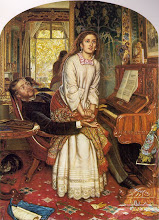
Today is the feast day of Saint Mechthild of Hackeborn (1241-1298), shown above at left with her sister Gertrude; both women were Cistercians in the renowned Saxon abbey of Helfta, which was also the home of Saints Gertrude the Great, who shares her feast day, and Mechthild of Magdeburg, whose feast is November 19. Mechthild of Hackeborn was the abbey's choirmistress, and her beautiful singing voice earned her the sobriquet "God's Nightingale."
Like Saint Augustine, Mechthild experienced a heightened sense of hearing, which afforded her the grace of auditory visions. In one, Christ proffered a harp drawn out of His Sacred Heart, explaining that the harp was Himself, and the strings were “all chosen souls which are all one in God through love”; then He, who Mechthild described as the “high chanter of all chanters,” struck the harp and led “all the angels with delectable sound” as they sang the hymn Regem regum Dominum: "O come, let us worship the Lord, the King of kings, Who is himself the Crown of all the Saints." Her visions were transcribed and published in the fourteenth century as the Liber specialis gratiae, which was translated into middle English as The Booke of Ghostlye Grace. The Liber also became popular in Florence as La Laude di donna Matelda. Indeed, some scholars have suggested that the beautiful lady who Dante hears singing "Venite, benedicti patris mei" on a riverbank in Canto XXVIII of Purgatorio, and who is later identified as Matilda, is in fact Saint Mechthild.
May Saint Mechthild of Hackeborn pray for us, that our ears and voices may be opened to hear and proclaim the truth.
UPDATE: After looking more closely at the image above, I'm starting to doubt whether the figure on the left is really Mechthild of Hackeborn. As a fully-professed Cistercian nun, she would be wearing the same habit as her sister, Gertrude (known as Gertrude of Helfta to distinguish her from Saint Gertrude the Great), shown on the right. I'm wondering now if the figure on the left is actually Saint Mechthild of Magdeburg, who had been a Beguine -- a woman living in a lay community of the faithful -- before joining the abbey at Helfta; as such, she would have worn a different dress and habit before profession. There is indeed some confusion in the biographical records of these saintly women, owing perhaps to the remarkable plethora of mystical Mechthilds and Gertrudes all in Helfta at the same time.











No comments:
Post a Comment